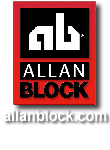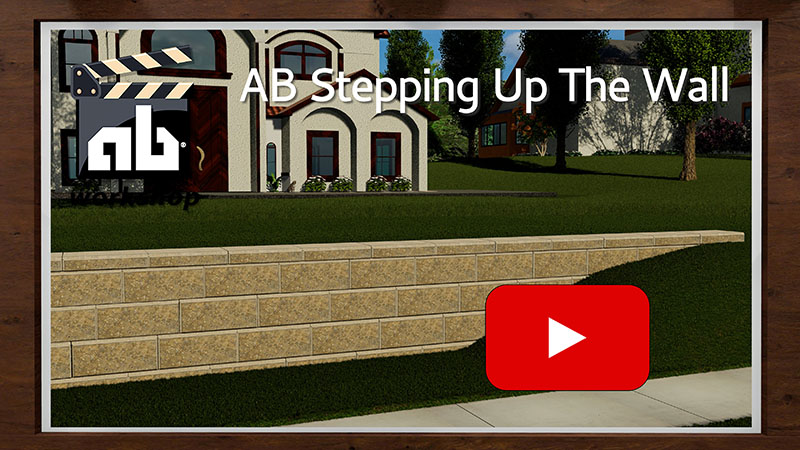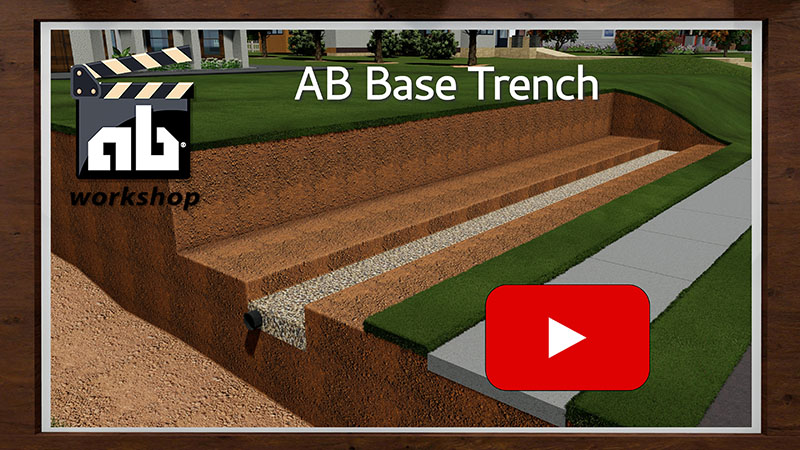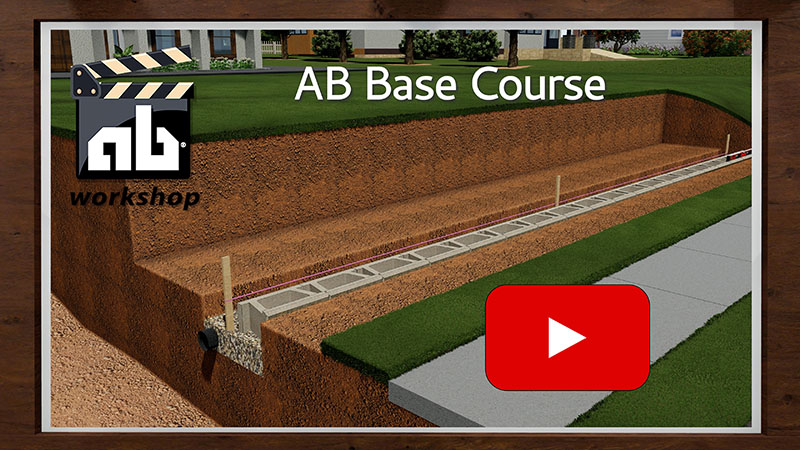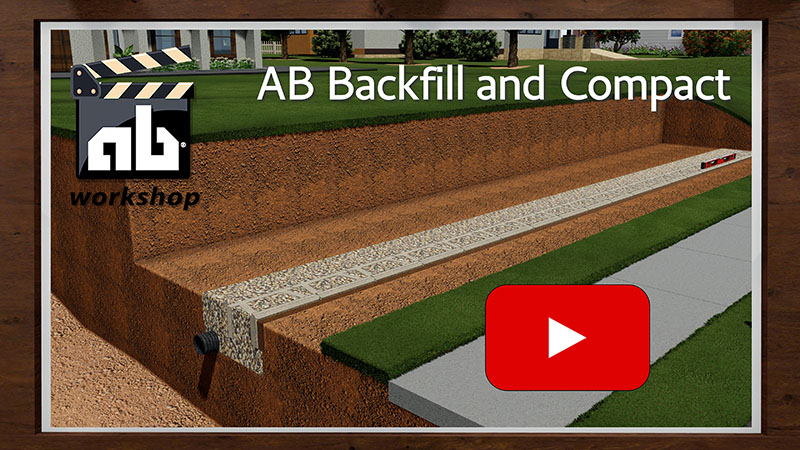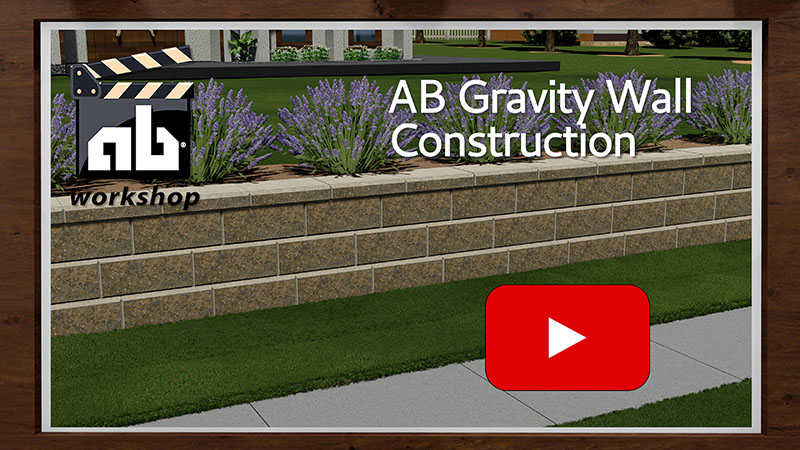Gravity Retaining Wall Construction
For AB, AB Aztec, AB Metro & AB Europa Walls

Gravity retaining wall typical cross section

Gravity retaining wall base course section
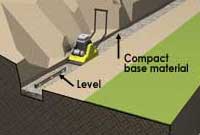
Install base material, level, and compact.

Level blocks, adjust where needed.
Step 1: Site Prep and Excavation
If you are building with AB Fieldstone that uses recycled materials, go to AB Fieldstone installation
- Remove surface vegetation and organic soils
- Per the approved plan, excavate base trench a minimum of 24 in. (610 mm) wide and 12 in. (300 mm) deep.*
- Remove unsuitable soils and replace with compactible materials.
- Buried block should be a minimum of 6 in. (150 mm). Check plans to see how much buried block is required.
- Compact and level trench.

Start retaining wall at the lowest elevation
Stepping up the Wall Base
Walls built on a sloping grade require a stepped base.
- Begin excavation at the lowest point and dig a level trench into the slope until it is deep enough to accommodate the base material and one entire block.
- At this point step up the height of one block, and begin a new section of base trench.
- Continue to step up as needed to top of slope.
- Always bury at least one full unit at each step.
Step 2: Install Base Material
- Per the approved plans, place a minimum of 6 in. (150 mm) of wall rock in the base trench and rake smooth.*
- Compact and level base material.
- Site Soils Engineer should verify that a proper base is established.
Step 3: Install Base Course
- Begin at the lowest retaining wall elevation. Place retaining wall blocks on base material in the center of the trench. Check and adjust for level and alignment of each unit.
- Drain pipe is required for retaining walls over 4 ft. (1.2 m) tall or are constructed in silty or clay soils. See approved plans for location and specifications. Refer to design details on an alternate drain location.
Step 4: Install Wall Rock and Backfill Materials
- Fill the hollow cores and a minimum of 12 in. (300 mm) behind the retaining wall with wall rock.
- Use approved soils to backfill behind the wall rock and in front of the base course.
- Use a plate compactor to consolidate the area behind the block. Compact in lifts of 8 in. (200 mm) or less.
Step 5: Install Additional Courses
- Remove all excess material from the top surface of retaining wall blocks. This can be done when installing the next course of block, by sliding the block into place.
- Stack the next course of blocks so that the vertical seams are offset from the blocks below by at least 3 in. (75 mm) or 1/4 the length of the block.
- Check and adjust for level, alignment and the wall batter as the retaining wall stacks up.
- Fill the block cores and behind the block with wall rock a minimum of 12 in. (300 mm). Use approved soils to backfill behind the wall rock.
- From course 2 and above use a plate compactor to compact directly on the blocks as well as the area behind the blocks. Compact in liftsof 8 in. (200 mm) or less.
- Complete the retaining wall to required height. See finishing details for information on retaining wall ending options.
- Use 8 - 12 in. (200-300 mm) of low permeable fill on the last lift to finish off wall.
*For walls under 4 ft. (1.2 m), an 18 in. (460 mm) wide by 10 in. (250 mm) deep trench with 4 in. (100 mm) of wall rock base material is acceptable.
For AB Fieldstone Walls
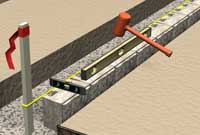
Install AB Fieldstone facing units. Level and Adjust
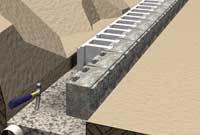
Install AB Fieldstone anchoring units
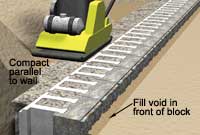
Install and compact wall rock and backfill soils
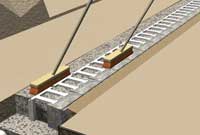
Sweep to remove excess materials for proper placement of the next course

Compact wall rock and backfill soils starting on the blocks
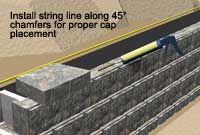
Install filter fabric and string line to place AB Caps
Base Course for AB Fieldstone
- Begin at the lowest wall elevation by placing the AB Fieldstone facing units on the base material towards the front of the trench, leaving room for the AB Fieldstone anchoring unit so when entire assembly is installed it is centered on the base materials. Check each unit and adjust for level and alignment. The facing units can be randomly flipped upside down to give different facing appearances.
- For proper placement of the anchoring units, use a brick hammer or shovel to create a small trench to allow for the lip.
- Install the anchoring units into the receiving slots of the facing units with the lip facing down in the trench just created. Make adjustments to ensure anchoring units are installed reasonably level with the facing unit. The anchoring units should never be installed higher than the facing unit. Except for special applications like corners, each anchoring unit should match up with one facing unit.
- A drain pipe is required for any reinforced wall, gravity walls over 4 ft. (1.2 m) tall or sites with poor drainage. Place the drain pipe at the lowest possible point toward the back of the trench and vent to daylight every 50 ft. (15 m). See approved plans for location and specifications. Learn more about water management.
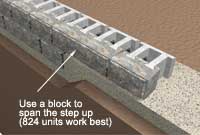
Start retaining wall at the lowest elevation. Use 824 units to span the step up (if available)
Stepping up the Wall Base
When building Step-Ups into a slope, always begin at the lowest wall elevation of the base course.
To create a Step-Up, span a block between the leveling pad and the block course below. Step-Ups are most stable when the upper block has sufficient bearing on the lower block. The length of the 824 assembly (if available) provides the flexibility to make this block ideal for this application. An 812 assembly will work as well.
Install Wall Rock and Backfill Materials

Backfill with wall rock
- Fill the hollow cores and a minimum of 12 in. (300 mm) behind the wall with wall rock. Install the wall rock to be level or below the receiving notch of the anchoring unit.
- Use approved soils to backfill behind the wall rock and in front of the base course.
- Use a plate compactor to consolidate the area behind the blocks.
- Compact in lifts of 8 in. (200 mm) or less
Additional Courses for AB Fieldstone
- Remove all excess material from the top surface of the AB Fieldstone units. This should include running a brush or broom across the receiving notch to remove any debris.
- For faster installation and alignment of the second course, install the first AB Fieldstone facing unit and AB Fieldstone anchoring unit at the same time. Make adjustments so that the vertical seams are offset from the blocks below by at least 3 in. (75 mm) or ¼ the length of block.
- Install the rest of the facing units using the first block as a placement guide.
- Place anchoring units into the receiving slots of the facing units. Slide the two piece assembly so that the lip of the anchoring unit is placed into the receiving notch of the block on the course below. Each anchoring unit should match up with one facing unit.
- Check and adjust for level and alignment of the facing units.
- Fill the hollow cores and a minimum of 12 in. (300 mm) behind the wall with wall rock. Install the wall rock behind the anchoring unit to be level or below the receiving notch or approximately 0.5 in. (12 mm) below the top of the anchoring unit.
- Use approved soils to backfill behind the wall rock.
- From course 2 and above use a plate compactor to compact directly on the blocks as well as the area behind the blocks. Compact in lifts of 8 in. (200 mm) or less.
- Remove excess material from the top surface and repeat steps to complete the wall to the height required. More for information on ending walls with turn-ins.

